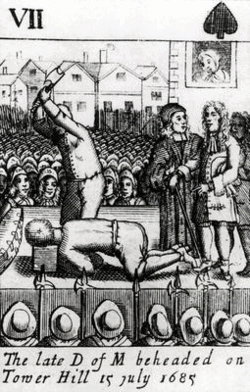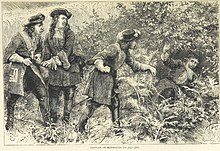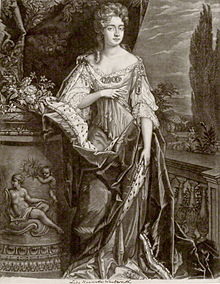James Scott, 1st Duke of Monmouth
Great Tower Hill , Tower of London, Liberties of the Tower, England | |
|---|---|
| Nationality | English |
| Spouse(s) | |
| Issue | 9, including: |
| Parents | |
| Military career | |
| Allegiance | Kingdom of England |
| Service/ | English Army |
| Years of service | 1665–1685 |
| Rank | General |
| Battles/wars | |
James Scott, 1st Duke of Monmouth, 1st Duke of Buccleuch,
The Duke of Monmouth served in the
Biography
Parentage and early life
Research by Hugh Noel Williams suggests that Charles had not arrived in
James had a younger sister or half-sister, Mary Crofts, whose father may have been
As an
In March 1658, young James was kidnapped by one of the King's men, sent to Paris, and placed in the care of William Crofts, 1st Baron Crofts, whose surname he took. He briefly attended a school in Familly.[3]
Officer and commander

On 14 February 1663, almost 14 years old, shortly after having been brought to England, James was created Duke of Monmouth, with the subsidiary titles of
On 20 April 1663, just days after his 14th birthday, the Duke of Monmouth was married to the heiress
In 1665, at the age of 16, Monmouth served in the English fleet under his uncle, the Duke of York, in the Second Anglo-Dutch War.[3] In June 1666, he returned to England to become captain of a troop of cavalry.[3] On 16 September 1668 he was made colonel of the His Majesty's Own Troop of Horse Guards.[3] He acquired Moor Park in Hertfordshire in April 1670.[12] Following the death in 1670, without a male heir, of Josceline Percy, 11th Earl of Northumberland, the earl's estates reverted to the Crown. King Charles II awarded the estates to Monmouth. The Countess of Northumberland successfully sued for the estates to be returned to the late Earl's only daughter and sole heiress, Lady Elizabeth Percy (1667–1722).[13]
At the outbreak of the
In 1674, Monmouth became
Claim to the Crown

In 1678, Monmouth was the commander of the Anglo-Dutch brigade, now fighting for the
Rebellion
As his popularity with the masses increased, Monmouth was obliged to go into exile in the Dutch United Provinces in September 1679.[3] Following the discovery of the so-called Rye House Plot in 1683, which aimed to assassinate both Charles II and his brother James, Monmouth, who had been encouraged by his supporters to assert his right to the throne, was identified as a conspirator.[17] On King Charles II's death in February 1685, Monmouth led the Monmouth Rebellion, landing with three ships at Lyme Regis in Dorset in early June 1685, in an attempt to take the throne from his uncle, James II and VII.[18] He published a "Declaration for the defence and vindication of the protestant religion and of the laws, rights and privileges of England from the invasion made upon them, and for delivering the Kingdom from the usurpation and tyranny of us by the name of James, Duke of York": King James II and VII responded to this by issuing an order for the publishers and distributors of the paper to be arrested.[19]
Monmouth declared himself as the rightful King at various places along the route including Axminster, Chard,[20] Ilminster and Taunton.[3] The two armies met at the Battle of Sedgemoor on 6 July 1685, the last clear-cut pitched battle on open ground between two military forces fought on English soil: Monmouth's makeshift force could not compete with the regular army, and was soundly defeated.[21]
Capture
Following the battle a reward of £5,000 was offered for his capture.[22] On 8 July 1685, Monmouth was captured and arrested near Ringwood in Hampshire,[23] by tradition "in a field of peas". The events surrounding his capture are described by George Roberts in Tait's Edinburgh Magazine.[24]
Upon the 7th, about five in the morning, some of the Lord Lumley's said scouts riding in the road near Holt Lodge in Dorset, four miles [six kilometres] west of Ringwood in Hampshire, just at the turn of a cross way, surprised and seized two suspected persons, which, when the Lord Lumley came up, proved to be Lord Grey and Hollyday the guide. Lord Lumley now commenced a strict examination of the cottages scattered thickly over this heathy country, and called those to assist him who were acquainted with the locality. Sir William Portman was informed of the capture that had been made, and hastened to the spot, with as many of his horse and foot as he could suddenly get together. As Lord Lumley was making inquiries of the cottagers, a poor woman, Amy Farrant, directed him to a hedge, over which she had seen two men go. This hedge proved to be part of the outbounds of several enclosed fields, some overgrown with fern and brakes, and others sown with rye, peas, and oats. The assembled militia were placed around these outbounds, at short distances from each other, while horse and foot performed their assigned duty – that of beating about within.[25]
When the Duke had left his horse at Woodyates Inn, he exchanged clothes with a shepherd, who was soon discovered by local loyalists and interrogated. Dogs were then put onto the Duke's scent. Monmouth dropped his gold snuff box, full of gold pieces, in a pea field, where it was afterwards found.[26]

From Woodyates Inn the Duke had gone to Shag's Heath, in the middle of which was a cluster of small farms, called the "Island". Amy Farrant gave information that the fugitives were concealed within the Island. The Duke, accompanied by Busse and Brandenburgher, remained concealed all day, with soldiers surrounding the area and threatening to set fire to the woodland. Brandenburgher deserted him at 1 am, and was later captured and interrogated, and is believed to have given away the Duke's hiding place. The spot was at the north-eastern extremity of the Island, now known as Monmouth's Close, in the manor of Woodlands, the property of the Earl of Shaftesbury. At about 7 am Henry Parkin, a militia soldier and servant of Samuel Rolle, discovered the brown skirt of Monmouth's coat as he lay hidden in a ditch covered with fern and brambles under an ash tree, and called for help. The Duke was seized. Bystanders shouted out "Shoot him! shoot him!", but Sir William Portman happening to be near the spot, immediately rode up, and laid hands on him as his prisoner. Monmouth was then "in the last extremity of hunger and fatigue, with no sustenance but a few raw peas in his pocket. He could not stand, and his appearance was much changed. Since landing in England, the Duke had not had a good night's rest, or eaten one meal in quiet, being perpetually agitated with the cares that attend unfortunate ambition". He had "received no other sustenance than the brook and the field afforded".[27]
The Duke was taken to Holt Lodge, in the parish of Wimborne, about one mile (1.5 kilometres) away, the residence of Anthony Etterick, a magistrate who asked the Duke what he would do if released, to which he answered: "that if his horse and arms were but restored to him at the same time, he needed only to ride through the army; and he defied them to take him again". The magistrate ordered him taken to London.[22]
Attainder and execution
| Act of Parliament | |
 1 Ja. 2. c. 2 | |
| Dates | |
|---|---|
| Royal assent | 16 June 1685 |
| Other legislation | |
| Repealed by | Statute Law Revision Act 1948 |
Status: Repealed | |
| Text of statute as originally enacted | |
Following Monmouth's capture,
Whereas James Duke of Monmouth has in an hostile Manner Invaded this Kingdom and is now in open Rebellion Laying War against the King contrary to the Duty of his Allegiance, Be it enacted by the Kings most Excellent Majesty by and with the Advice and Consent of the Lords Spiritual and Temporal and Commons in this Parliament assembled and by the Authorities of the same, That the said James Duke of Monmouth Stand and be Convicted and Attainted of High-Treason and that he suffer Paines of Death and Incurr all Forfeitures as a Traitor Convicted and Attainted of High Treason.[29]
The King took the unusual step of allowing his nephew an audience, despite having no intention of extending a

Monmouth was
Monmouth was buried in the
Popular legends
According to legend, a portrait was painted of Monmouth after his execution: the tradition states that it was realised after the execution that there was no official
One of the many theories about the identity of the
Henry Purcell set to music (Z. 481) a satirical poem by an unidentified author, ridiculing Monmouth and his parentage:[41]
A grasshopper and a fly,
In summer hot and dry,
In eager argument were met
About priority.
Says the fly to the grasshopper:
"From mighty race I spring,
Bright Phoebus was my dad 'tis known,
And I eat and drink with a king."
Says the grasshopper to the fly:
"Such rogues are still preferr'd;
Your father might be of high degree,
But your mother was but a turd."
So, rebel Jemmy Scott,
That did to the empire soar,
His father might be the Lord knows what,
But his mother we knew a whore.
Arms
James Scott's first coat of arms was initially granted in 1663 at the same time he was created Duke of Monmouth:[42]
Quarterly, 1st and 4th, Ermine, on a
This version of the arms, which consisted in a creative reorganisation of the Royal Arms, drew numerous complaints as it did not include any marker to signify his illegitimacy, and rumours that Charles might attempt to legitimise James started to spread.[42]
Four years later, after James' marriage, and with Charles' growing realisation that he would not legitimise him, a new design was granted:
Children


His marriage to Anne Scott, 1st Duchess of Buccleuch resulted in the birth of six children:[11]
- Charles Scott, Earl of Doncaster (24 August 1672 – 9 February 1673/1674)
- Henrietta Hyde, daughter of Laurence Hyde, 1st Earl of Rochester. They were parents to Francis Scott, 2nd Duke of Buccleuch.
- Lady Anne Scott (17 February 1675 – 13 August 1685)
- Henry Scott, 1st Earl of Deloraine (1676 – 25 December 1730)
- Francis Scott (died an infant; buried 8 December 1679)
- Lady Charlotte Scott (died an infant; buried 5 September 1683)
His affair with his mistress Eleanor Needham, daughter of Sir Robert Needham of Lambeth resulted in the birth of three children:[11]
- James Crofts(died March 1732), major-general in the Army.
- Henrietta Crofts (c. 1682 – 27 February 1730). She was married around 1697 to Charles Paulet, 2nd Duke of Bolton.
- Isabel Crofts (died young)
Toward the end of his life he conducted an affair with Henrietta, Baroness Wentworth.[11]
Family tree
| Edward Hyde 1609–1674 | Charles I 1600–1649 | ||||||||||||||||||||||||||||||||||||||||||||
| Henry Hyde 1638–1709 | Anne Hyde 1637–1671 | James II & VII 1633–1701 | Mary of Modena 1658–1718 | Mary 1631–1660 | Charles II 1630–1685 | ||||||||||||||||||||||||||||||||||||||||
James the old pretender 1688–1766 | |||||||||||||||||||||||||||||||||||||||||||||
Mary II 1662–1694 | William III & II 1650–1702 | (illegitimate) James Scott 1649–1685 | |||||||||||||||||||||||||||||||||||||||||||
References
- ^ Fraser 1979, pp. 55–56.
- ^ Seccombe, Thomas (1899). . In Lee, Sidney (ed.). Dictionary of National Biography. Vol. 59. London: Smith, Elder & Co. pp. 259–260. cites Gardiner, Hist. of Civil War, iii. 238; Boero, Istoria...di Carlo II, Rome, 1863.
- ^ doi:10.1093/ref:odnb/24879. (Subscription or UK public library membershiprequired.)
- ^ Williams, p. 6
- ^ "Scotland's DNA: Descended from lost tribes…and related to Napoleon". The Scotsman. 17 April 2012. Retrieved 20 April 2012.
- ^ Harrison, Bruce (2005). "The Family Forest Descendants of Lady Joan Beaufort". Milisecond Publishing. p. 532. Retrieved 15 October 2015.[permanent dead link]
- ^ "Lucy Walter". Dictionary of Welsh Biography. National Library of Wales. Retrieved 13 May 2012.
- ^ a b "Scott, James Crofts, Duke of Monmouth". University of Hull. Retrieved 13 May 2012.[permanent dead link]
- ^ "Setting the Scene in Wessex: the 17th Century in Literature and Drama". Retrieved 13 May 2012.
- ^ Brydges, Sir Egerton (1812). Collins's Peerage of England; Genealogical, Biographical and Historical. Vol. 3. F.C. and J. Rivington. p. 511.
- ^ a b c d Burke, Bernard (1914). Genealogical and Heraldic Dictionary of the Peerage and Baronetage of the British Empire. London: Burke's Peerage Limited. p. 320.
- ^ "Moor Park". Archived from the original on 12 December 2013. Retrieved 19 April 2012.
- ^ "Journal of the House of Lords: Volume 13, 1675-1681". British History Online. His Majesty's Stationery Office, London, 1767-1830. Retrieved 8 September 2022.
- ^ Watson p.67-68
- ^ "Monmouth, James, Duke of Monmouth (MNMT663J)". A Cambridge Alumni Database. University of Cambridge.
- ^ "No. 1328". The London Gazette. 8 August 1678. p. 1.
- ^ "No. 1848". The London Gazette. 2 August 1683. p. 2.
- ^ "No. 2042". The London Gazette. 11 June 1685. p. 1.
- ^ "No. 2043". The London Gazette. 15 June 1685. p. 1.
- ^ "King Crowned in Chard". Chard Tourist Guide. 26 June 2005. Retrieved 13 May 2012.
- ^ "No. 2049". The London Gazette. 6 July 1685. p. 1.
- ^ a b Roberts, p. 109
- ^ "No. 2050". The London Gazette. 9 July 1685. p. 1.
- ^ Roberts, George (1 January 1845). The Life and Rebellion of the Duke of Monmouth. Vol. 12. Tait's Edinburgh Magazine. p. 57.
- ^ "Official account published by command", quoted in Tait's Edinburgh Magazine
- .
- ^ Tait's Edinburgh Magazine
- ^ Raithby, p.2
- ^ The Statutes of the Realm, vol. VI (1819); James the Second, 1685: An Act to Attaint James Duke of Monmouth of High-Treason. Chapter II. Rot. Parl. nu. 2. at british-history.ac.uk, accessed 23 April 2020
- ^ Beatty, p. 60
- ^ "No. 2051". The London Gazette. 13 July 1685. p. 2.
- ^ Macaulay, p.491
- ^ "Tower of London: Fact sheet" (PDF). Archived from the original (PDF) on 27 March 2009. Retrieved 10 October 2009.
- ^ Spencer, p.54: "Monmouth had a particularly grisly end, the executioner's axe striking seven times before his head severed"
- ^ "The Chapel of St. Peter ad Vincula and Tower Green". English Monarchs. Retrieved 24 September 2017.
- ^ "Earl of Doncaster". Archived from the original on 19 January 2021. Retrieved 19 May 2012.
- ^ "Tourist Sights Portrait of the Duke of Monmouth in England". Trivia-library.com. Retrieved 13 May 2012.
- ^ "National Portrait Gallery NPG 151". National Portrait. Archived from the original on 17 December 2007. Retrieved 13 May 2012.
- ^ "National Portrait Gallery NPG 1566". National Portrait. Archived from the original on 25 February 2008. Retrieved 13 May 2012.
- ^ Shaw, Samuel, "Duke of Monmouth: Man in the Iron Mask", in Oxford Journals (Oxford, 1870), Vol s4-V, No 120.
- ^ Spink, Ian (ed.). Henry Purcell: Duets, Dialogues and Trios. Vol. 22B (Purcell Society ed.). Purcell Society. Archived from the original on 10 September 2018. Retrieved 4 December 2016.
- ^ a b c Holder, Samantha. "The Baton Sinister". The Wrong Side of the Blanket. Retrieved 13 January 2024.
- ^ a b Murdock, Paul J. "Illegitimate Royal Offspring". A Royal Heraldry. Retrieved 19 January 2024.
Sources
- Beatty, Michael (2003). The English Royal Family of America, from Jamestown to the American Revolution. McFarland and co. ISBN 978-0-7864-1558-8.
- Macaulay, Thomas Babington (1878). The History of England from the Accession of James II, Volume I. Philadelphia: J. B. Lippincott & Co.
- ISBN 978-0-297-77571-3
- Raithby, John (1819). "Chapter II. Rot. Parl. nu. 2., Statutes of the Realm". James the Second, 1685: An Act to Attaint James Duke of Monmouth of High-Treason. Vol. 6: 1685–94.
- Roberts, George (1844). Life, progresses and rebellion of James, Duke of Monmouth to his capture and execution. London: Longmans, Brown, Green and Longmans.
- Spencer, 9th Earl Spencer, Charles (2005). Blenheim, Chapter 3: John Churchill. London: Phoenix. ISBN 978-0304367047.)
{{cite book}}: CS1 maint: numeric names: authors list (link - Watson, J.N.P. (1979). Captain General and Rebel Chief: The Life of James, Duke of Monmouth. London: George Allen & Unwin. ISBN 978-0-04-920058-6.
- Williams, Hugh Noel (1915). Rival sultanas. Hutchinson & Co.
Further reading
 Media related to James Scott, 1st Duke of Monmouth at Wikimedia Commons
Media related to James Scott, 1st Duke of Monmouth at Wikimedia Commons- . The Nuttall Encyclopædia. 1907.
- Keay, Anna (2016). The Last Royal Rebel: The Life and Death of James, Duke of Monmouth. New York: Bloomsbury. ISBN 978-1-62040-934-3.
- Wyndham, Violet (1976). Protestant Duke: Life of the Duke of Monmouth. Littlehampton Book Services. ISBN 978-0-297-77099-2.



